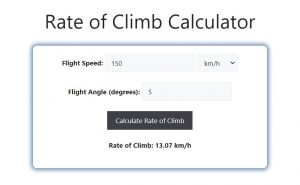About Rate of Climb Calculator (Formula)
The rate of climb (ROC) is a crucial parameter in aviation, indicating how quickly an aircraft can gain altitude. It is essential for flight planning, ensuring aircraft performance meets safety standards during takeoff, ascent, and emergency procedures. This article provides a guide on calculating the rate of climb using a simple formula, offers an example, and answers common questions about the rate of climb.
Formula
To calculate the rate of climb, use the following formula:
Rate of Climb (ROC) = Velocity (V) * sin(Flight Path Angle (fa))
Where:
- ROC is the rate of climb, typically measured in feet per minute (fpm) or meters per second (m/s)
- V is the aircraft’s velocity, usually in knots or meters per second
- fa is the flight path angle, the angle between the aircraft’s trajectory and the horizontal plane
How to Use
- Determine the Aircraft’s Velocity (V): Measure the aircraft’s velocity, which can be indicated by the airspeed indicator, in knots or meters per second.
- Determine the Flight Path Angle (fa): Identify the flight path angle, typically provided by the aircraft’s instrumentation or estimated during flight.
- Apply the Formula: Multiply the velocity by the sine of the flight path angle to find the rate of climb.
- Interpret the Result: The result will give you the rate of climb, indicating how quickly the aircraft is gaining altitude.
Example
Assume an aircraft is flying at a velocity of 150 knots, and the flight path angle (fa) is 5 degrees. Using the formula:
Rate of Climb = Velocity * sin(Flight Path Angle)
Rate of Climb = 150 knots * sin(5°)
Rate of Climb ≈ 150 * 0.0872
Rate of Climb ≈ 13.08 knots
Converting this to feet per minute (fpm), if 1 knot = 101.27 fpm:
Rate of Climb ≈ 13.08 * 101.27
Rate of Climb ≈ 1324.62 fpm
So, the rate of climb is approximately 1325 feet per minute.

FAQs
- What is the rate of climb?
The rate of climb (ROC) is the speed at which an aircraft gains altitude, usually expressed in feet per minute (fpm) or meters per second (m/s). - Why is calculating the rate of climb important?
Calculating the rate of climb is essential for flight planning, ensuring the aircraft can safely clear obstacles during takeoff and ascent, and managing fuel efficiency. - How does velocity affect the rate of climb?
Higher velocity can increase the rate of climb if the flight path angle remains constant, as the aircraft moves upward more quickly. - What is the flight path angle?
The flight path angle is the angle between the aircraft’s trajectory and the horizontal plane, influencing how steeply the aircraft climbs. - Can the rate of climb be negative?
Yes, a negative rate of climb indicates a descent rather than an ascent, meaning the aircraft is losing altitude. - Is the rate of climb the same for all aircraft?
No, the rate of climb varies based on aircraft type, engine power, weight, and aerodynamic design. Performance specifications provide the maximum rate of climb for each aircraft. - How does weight affect the rate of climb?
Increased weight reduces the rate of climb as the aircraft requires more power to overcome gravity and maintain ascent. - What units are commonly used for the rate of climb?
The rate of climb is commonly measured in feet per minute (fpm) or meters per second (m/s). - How is the rate of climb displayed in an aircraft?
The rate of climb is displayed on the vertical speed indicator (VSI) in the cockpit, showing the aircraft’s ascent or descent rate. - Can wind affect the rate of climb?
Wind does not directly affect the rate of climb, but headwinds or tailwinds can influence the aircraft’s ground speed and fuel consumption during ascent. - What is a good rate of climb for a commercial airliner?
A typical rate of climb for a commercial airliner ranges between 1,500 to 3,000 feet per minute, depending on the aircraft and conditions. - How can the rate of climb be improved?
The rate of climb can be improved by reducing weight, increasing engine power, or climbing at the optimal airspeed and angle of attack. - Is the rate of climb important during emergency procedures?
Yes, maintaining an adequate rate of climb is critical during emergencies, such as engine failure or obstacle avoidance, to ensure safe altitude gain. - How does altitude affect the rate of climb?
As altitude increases, air density decreases, reducing engine performance and aerodynamic lift, which can lower the rate of climb. - What is the difference between rate of climb and climb gradient?
The rate of climb is the vertical speed of ascent, while climb gradient refers to the ratio of vertical to horizontal distance covered, usually expressed as a percentage. - Does the rate of climb vary during a flight?
Yes, the rate of climb typically varies during different flight phases, such as takeoff, initial climb, and cruise climb, based on power settings and airspeed. - Can rate of climb be calculated for helicopters?
Yes, the rate of climb can be calculated for helicopters using the same principles, considering their specific velocity and flight path angle. - Why might a pilot need to adjust the rate of climb?
A pilot may adjust the rate of climb to manage fuel consumption, avoid turbulence, comply with air traffic control instructions, or ensure obstacle clearance.
Conclusion
The Rate of Climb Calculator is an essential tool for pilots, flight planners, and aviation enthusiasts to determine how quickly an aircraft can gain altitude. By using the provided formula, you can calculate the rate of climb, ensuring safe and efficient flight operations. Understanding the rate of climb helps in planning flight paths, optimizing fuel use, and managing various phases of flight for different aircraft.